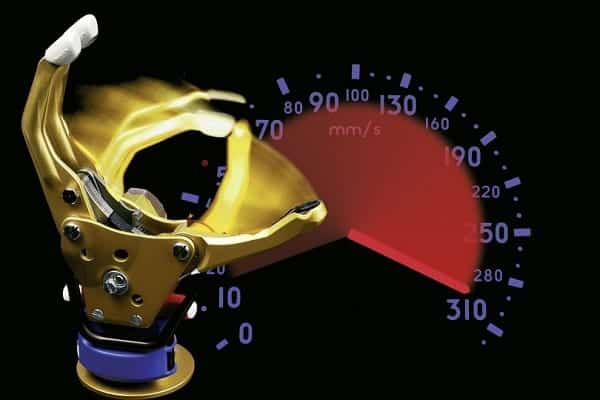The Ottobock SensorHand Speed has the advantages of a powered hook in speed, durability, and ease of use, but with more sophisticated grasping features and the ability to look like a natural hand.
What’s On This Page?
- A Quick Look at the SensorHand Speed
- Grip Patterns & Control System
- Thumb Rotation
- Proportional Speed Control
- Auto-Grasp
- FlexiGrip
- Sensory Feedback
- Wrist Design
- Lift Capacity & Grip Strength
- Durability
- Water and Dust Resistance
- Glove Options
- Batteries
- User Software
- Suitability for Above-the-Elbow Solutions
- Price
- Warranty
- User Feedback Survey & Results
- Considerations Before Buying a SensorHand Speed
- Related Information
A Quick Look at the SensorHand Speed
It is not easy to find one video that provides a complete demonstration of the SensorHand, so we’re going to use a few short videos. First, here is what the hand looks like (you can stop watching this video after 20 seconds):
As you can see, this is not a multi-articulating bionic hand, which is why we list it as an Electric Terminal Device (ETD).
However, it can be made to look like a natural hand by using a glove, as shown in this short overview video of what Ottobock refers to as its “MyoBock System Electric Hands”. The section on the SensorHand starts at 1:04:
The most common question we get about this device is: why was it created? From our standpoint, it fills a niche. Multi-articulating hands — what most people think of as a modern bionic hand — would be the ideal solution if they could perform every task desired by end-users. But the current versions of these hands fall far short of this goal.
One area of deficiency is speed. Most multi-articulating bionic hands can be a bit slow to respond to user commands (the Michelangelo and the Psyonic Ability Hand are two exceptions to this). With its simpler design, the SensorHand opens and closes at a speed equivalent to the average speed of a natural hand, which makes it more efficient and intuitive to use.
Another problem with multi-articulating hands is durability. Although they have been improved in recent years, they still break too frequently. That’s why there’s still a market for rugged electric grippers and hooks. But these devices cannot be made to look like a natural hand. The SensorHand Speed can be made to look that way while still offering improved durability.
Multi-articulating bionic hands are more complex. For example, they offer multiple grip patterns, i.e. different combinations of fingers and the thumb close depending on the selected grip. This often requires users to switch to the appropriate grip before attempting a task. The SensorHand is simpler. Its only grip pattern is to open and close all three digits in unison. This means that the SensorHand cannot perform certain tasks very well, such as typing on a keyboard or operating a mouse. But it can quickly grasp most objects, which is by far the most common task for bionic hands, and it also has a few additional features that give it superior grasping capabilities compared to a powered hook. Also, because of its simplicity, it can be more easily used by those with only one suitable site for a myoelectric sensor.
So, summarizing this, if you want a device that can look like a hand, can securely grasp objects, and is simpler, faster, and more durable than a multi-articulating hand (but less capable for certain tasks), that’s why the SensorHand Speed exists.
Notice, however, that we did not mention price. While it’s true that the SensorHand is less expensive than Ottobock’s multi-articulating hands such as the bebionic and Michelangelo, it is considerably more expensive than some of the newer bionic hands like the TrueLimb, Hero Arm, and Zeus Hand. We do not think this is by design. Newer bionic limb companies are simply pushing prices downward, especially in the lower and middle price tiers.
SensorHand Speed Key Features
Grip Patterns & Control System
As mentioned, the SensorHand has only one grip pattern — opening and closing all three digits — so it does not require a complex control system.
However, it does offer numerous methods of control, including the option to use two electrodes or just one, which may be very important for some end-users depending on the remaining musculature in the residual limb. It can also be controlled using a transducer, an Ottobock switch, or a combination of a switch and one electrode.
Finally, the SensorHand has some unique grasping features, which we describe in subsequent sections.
Thumb Rotation
The SensorHand’s thumb does not rotate, as this action is not part of its only grip pattern.
Proportional Speed Control
The SensorHand offers proportional speed control based on the strength of the user’s muscle signal, which is how most bionic hands handle this issue.
One of the features that makes the SensorHand unique is its ability to open and close quickly, as shown in this short, older video (this is not in English but the demonstration takes only a few seconds):
The only multi-articulating bionic hand that we’ve seen do something similar is Psyonic’s Ability Hand, as shown here:
Auto-Grasp
The SensorHand has an auto-grasp feature. It can sense when an object begins to slip from its grasp and automatically increase its grip force to re-secure the object. This is demonstrated starting at the 1:12 mark of this video (the same video that we showed you earlier):
FlexiGrip
Another nice feature of the SensorHand is a flexible grip that allows the user to passively change the position of an object being held without having to use a myoelectric signal to open and then re-close the device.
Sensory Feedback
The SensorHand does not provide any sensory feedback.
Wrist Design
Wrist options for the SensorHand include a plain lamination ring or a Quick-Disconnect Wrist with either passive or electrical wrist rotation.
Lift Capacity & Grip Strength
We have not been able to find any information on the SensorHand’s maximum lift capacity.
We do know that it has a maximum grip strength of 100 Newtons, which is quite high. Having said that, grip force tends to be measured in different ways by different companies, so comparisons between the grip strengths of competing devices may not be reliable.
Durability
We rely mostly on the results of our User Satisfaction Survey for an objective assessment of a bionic device’s durability. Because this article and the associated survey are quite new, it will likely be a few months before we have sufficient participants to publish results.
That having been said, it appears to us that the SensorHand Speed has been designed with ruggedness in mind. Certainly, having fewer “fingers”, motors, and moving parts should reduce the risk of breakage.
Water and Dust Resistance
The SensorHand Speed is not water-proof or dust-proof. A glove is required in situations where the hand is exposed to these elements, and the glove must not have any holes in it.
Glove Options
Ottobock offers a variety of glove options available in 3 sizes and 18 different colors.

Batteries
The preferred battery for the SensorHand is the Ottobock EnergyPack (757B20). Depending on the hand’s usage, this battery should last a full day and be charged each night. Fully recharging the battery when completely drained requires around 3.5 hours.
The estimated service life for this battery is two years.
Other Ottobock batteries can be used but may result in some usage restrictions.
User Software
Due to its simplicity, the SensorHand does not require a user software application.
Suitability for Above-the-Elbow Solutions
The SensorHand can be combined with electric elbows and the aforementioned wrist components to form an above-the-elbow solution.
We have not been able to find a formal list of compatible electric elbows or any official restrictions against the use of the hand with non-Ottobock elbows. We do know that, within the Ottobock family of devices, the SensorHand can be successfully paired with the DynamicArm.
Price
Based on our information, the SensorHand Speed should sell for between $20,000 and $30,000 US for a typical setup, including all socket and prosthetist fees.
For a complete list of prices for upper-limb ETDs, please see our ETD price list.
Warranty
The SensorHand offers a 2-year standard warranty against defects in materials or workmanship under normal use.
There is no extended warranty option.
Note, Ottobock recommends that the SensorHand should be serviced once every year but this does not appear to be required by the warranty.
User Feedback Survey & Results
Survey
Are you currently using the SensorHand Speed or have you used it in the past?
If so, why not help others by sharing your experiences in this quick survey:
Results
We do not yet have a sufficient number of survey participants to publish fair and accurate results for the SensorHand.
As soon as we do, we’ll update this section.
Considerations Before Buying the SensorHand Speed
We think that the SensorHand Speed is an interesting option for those who want a simpler, more rugged bionic hand that still resembles a hand (i.e. with the glove on) and that offers superior grasping features to that of a powered hook. We just wish it cost less given the emergence of increasingly capable multi-articulating bionic hands in the $10,000 to $20,000 price range.
Otherwise, we are reserving judgment until we hear back from end-users through our User Satisfaction Survey.
Related Information
For a list of competitor devices, see all upper-limb ETDs.
For a comprehensive description of all current upper-limb technologies, devices, and research, see our complete guide.
Click here for more information on Ottobock Upper-Limb Prosthetics.
